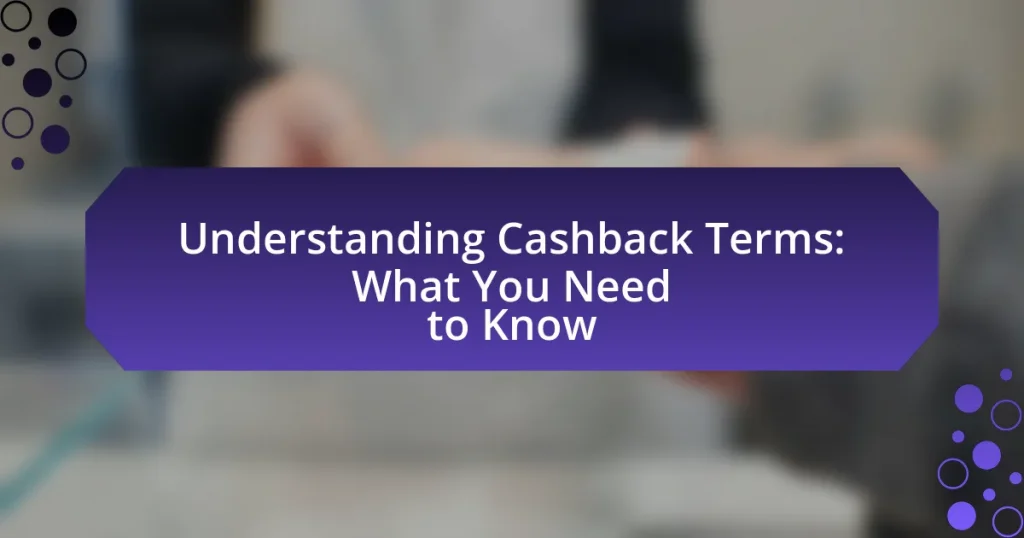Cashback websites are online platforms that enable consumers to earn cash rewards based on their purchases made through partnered retailers. This article provides a comprehensive comparison of various cashback websites, detailing their operational mechanisms, types, and the advantages they offer to users. Key factors such as cashback rates, user experience, and retailer partnerships are analyzed to help consumers identify the best cashback options available. Additionally, the article addresses potential drawbacks and risks associated with cashback websites, along with strategies for maximizing savings and effectively comparing offers across different platforms.

What are Cashback Websites?
Cashback websites are online platforms that allow consumers to earn a percentage of their purchases back as cash rewards when they shop through the site. These websites partner with various retailers and receive a commission for directing traffic to them, which they then share with the consumers in the form of cashback. For example, a user might earn 5% cashback on a $100 purchase, resulting in a $5 reward. This model incentivizes shopping through the cashback site, benefiting both the consumer and the retailer.
How do Cashback Websites operate?
Cashback websites operate by partnering with retailers to offer consumers a percentage of their purchase amount back as a reward. When a user makes a purchase through a cashback website, the retailer pays the website a commission, which is then shared with the consumer as cashback. For example, if a user buys a product worth $100 through a cashback site that offers 5% cashback, the retailer pays the site $10, and the user receives $5 back. This model incentivizes users to shop through the cashback platform, benefiting both the retailer and the consumer.
What mechanisms do Cashback Websites use to provide rewards?
Cashback websites provide rewards primarily through affiliate marketing agreements with retailers. When a user makes a purchase via a cashback website, the retailer pays a commission to the website for directing traffic and sales. This commission is then partially returned to the user as cashback. For example, if a retailer offers a 5% commission on sales, the cashback website might give the user 2% as a reward, keeping the remaining 3% as profit. This model incentivizes both the website and the user, creating a mutually beneficial relationship.
How do users earn cashback through these platforms?
Users earn cashback through these platforms by making purchases at participating retailers via the cashback website or app. When users click through to a retailer’s site from the cashback platform, the retailer tracks the transaction and pays a commission to the cashback platform, which is then shared with the user as a percentage of their purchase amount. For example, if a user buys a product worth $100 and the cashback rate is 5%, the user would earn $5 in cashback. This model incentivizes users to shop through these platforms, as they receive a monetary reward for their purchases.
What types of Cashback Websites are available?
There are several types of cashback websites available, including general cashback sites, niche cashback sites, and loyalty program cashback sites. General cashback sites, such as Rakuten and TopCashback, offer cashback across a wide range of retailers and categories. Niche cashback sites focus on specific industries or product categories, like travel or groceries, providing targeted deals. Loyalty program cashback sites, such as those associated with credit cards or specific retailers, reward users for purchases made through their platforms. Each type serves different consumer needs and preferences, enhancing the shopping experience by providing financial incentives.
What are the differences between general and niche cashback sites?
General cashback sites offer a wide range of cashback opportunities across various categories and retailers, while niche cashback sites focus on specific industries or product categories. General cashback sites, such as Rakuten, provide users with cashback options from numerous retailers, making them versatile for shoppers looking for deals across different sectors. In contrast, niche cashback sites, like Honey or TopCashback, cater to specific markets, such as travel or electronics, often providing higher cashback rates or exclusive deals within their targeted area. This specialization allows niche sites to attract users who are particularly interested in those specific products or services, potentially offering better rewards for targeted purchases.
How do affiliate partnerships influence cashback offers?
Affiliate partnerships significantly influence cashback offers by determining the percentage of cashback that consumers receive based on agreements between retailers and affiliate networks. These partnerships allow retailers to incentivize affiliates to promote their products, leading to higher visibility and sales. For instance, a retailer may offer a higher cashback rate to affiliates who drive more traffic, thereby encouraging affiliates to prioritize that retailer in their promotions. This dynamic can result in varying cashback rates across different platforms, as each affiliate partnership may negotiate unique terms. Consequently, consumers may find that cashback offers differ significantly depending on the affiliate relationships established by the cashback website.
What are the advantages of using Cashback Websites?
Cashback websites provide users with the advantage of earning money back on their online purchases. By utilizing these platforms, consumers can receive a percentage of their spending returned to them, which can accumulate to significant savings over time. For instance, studies indicate that users can earn anywhere from 1% to 10% cashback on various purchases, depending on the retailer and the specific cashback offer. This incentivizes shopping through these websites, as it effectively reduces the overall cost of goods and services. Additionally, cashback websites often feature exclusive deals and promotions that are not available through direct retailer websites, further enhancing the potential savings for users.
How can users maximize their savings through cashback?
Users can maximize their savings through cashback by strategically selecting cashback websites that offer the highest percentage returns on their purchases. By comparing different cashback platforms, users can identify those that provide better deals for specific retailers or categories, ensuring they earn more on each transaction. For instance, some cashback sites may offer up to 10% back on certain brands during promotional periods, while others may provide lower rates. Additionally, users should take advantage of stacking cashback offers with credit card rewards and promotional discounts, which can further enhance their total savings. Research indicates that consumers who actively compare cashback options can save an average of 5-10% more on their purchases compared to those who do not.
What additional benefits do Cashback Websites provide beyond cashback?
Cashback websites provide additional benefits beyond cashback, including exclusive discounts, promotional offers, and access to loyalty programs. These platforms often negotiate special deals with retailers, allowing users to save more on purchases. For instance, some cashback websites offer bonus cashback rates during specific promotional periods, enhancing the overall savings experience. Furthermore, many cashback sites feature user-friendly interfaces that aggregate deals from multiple retailers, simplifying the shopping process and ensuring users can easily find the best offers available.

How do Cashback Websites compare to each other?
Cashback websites vary in terms of cashback rates, user experience, and retailer partnerships. For instance, some websites like Rakuten offer higher cashback percentages on specific retailers, while others like TopCashback may provide better overall rates across a wider range of stores. Additionally, user interfaces differ; some platforms are more intuitive, enhancing the shopping experience, while others may have complex navigation. Furthermore, the number of participating retailers can significantly impact the value users receive; websites with extensive partnerships tend to offer more opportunities for earning cashback. According to a 2022 survey by Statista, Rakuten and TopCashback consistently rank among the top cashback sites based on user satisfaction and cashback rates, indicating that these factors are crucial for comparison.
What factors should be considered when comparing Cashback Websites?
When comparing cashback websites, key factors to consider include the cashback rates offered, the variety of retailers available, the payout methods, and the user experience. Cashback rates directly impact the amount of money returned to users; higher rates generally provide better value. The variety of retailers ensures that users can earn cashback on their preferred purchases, enhancing the site’s utility. Payout methods, such as direct deposit or gift cards, affect how easily users can access their earnings. Lastly, user experience, including website navigation and customer support, influences overall satisfaction and usability. These factors collectively determine the effectiveness and appeal of cashback websites.
How do cashback rates vary among different platforms?
Cashback rates vary significantly among different platforms, with some offering rates as high as 10% while others may provide only 1% or less. For instance, popular cashback websites like Rakuten typically offer rates between 1% to 10% depending on the retailer, while specialized platforms like TopCashback can feature rates exceeding 20% during promotional periods. This variation is influenced by factors such as partnerships with retailers, promotional campaigns, and the specific categories of products being purchased.
What role do user experience and interface play in the comparison?
User experience and interface play a critical role in comparing cashback websites by directly influencing user engagement and satisfaction. A well-designed interface enhances navigation, making it easier for users to find deals and understand cashback offers, which can lead to higher conversion rates. Research indicates that 88% of online consumers are less likely to return to a site after a bad experience, highlighting the importance of user experience in retaining customers. Additionally, intuitive interfaces can reduce the time spent on decision-making, allowing users to quickly assess and compare cashback options, ultimately impacting their purchasing decisions.
Which Cashback Websites offer the best deals?
Rakuten, TopCashback, and Swagbucks are among the cashback websites that offer the best deals. Rakuten provides up to 40% cashback at various retailers, while TopCashback often features higher rates than competitors, sometimes exceeding 50% on select purchases. Swagbucks allows users to earn cashback alongside rewards points, enhancing the overall value. These platforms are consistently rated highly for their user-friendly interfaces and extensive retailer partnerships, making them reliable choices for maximizing cashback savings.
What are the top-rated Cashback Websites based on user reviews?
The top-rated cashback websites based on user reviews include Rakuten, TopCashback, and Swagbucks. Rakuten is frequently praised for its extensive retailer partnerships and user-friendly interface, boasting an average user rating of 4.5 out of 5 stars on various review platforms. TopCashback is noted for offering higher cashback rates and no minimum payout threshold, with users rating it similarly high. Swagbucks, while primarily a rewards site, also provides cashback options and has garnered positive feedback for its diverse earning opportunities, achieving an average rating of 4.3 stars. These ratings reflect user satisfaction and the effectiveness of these platforms in delivering cashback rewards.
How do seasonal promotions affect cashback offers?
Seasonal promotions significantly enhance cashback offers by increasing the percentage of cashback available during specific times of the year, such as holidays or sales events. For instance, during Black Friday, many cashback websites boost their rates, offering up to 10% or more on purchases, compared to the usual 1-5%. This increase is often a strategic move to attract more shoppers and capitalize on heightened consumer spending during these periods. Data from the National Retail Federation indicates that holiday shopping can increase retail sales by as much as 30%, prompting cashback platforms to adjust their offers accordingly to remain competitive and appealing to consumers.

What are the potential drawbacks of Cashback Websites?
Cashback websites can have several potential drawbacks, including limited retailer participation, delayed payment processing, and potential for lower overall savings. Limited retailer participation means that not all stores offer cashback, which can restrict users’ options. Delayed payment processing can lead to frustration, as users may have to wait weeks or months to receive their cashback rewards. Additionally, some cashback websites may have complicated terms and conditions that can make it difficult for users to fully understand how to earn and redeem their cashback, potentially resulting in lower overall savings than anticipated.
What risks should users be aware of when using Cashback Websites?
Users should be aware of several risks when using cashback websites, including potential fraud, data privacy concerns, and the possibility of not receiving promised cashback. Fraudulent cashback websites can mislead users into providing personal information or making purchases without delivering the expected rewards. According to a 2021 report by the Better Business Bureau, consumers reported losing millions to scams related to cashback offers. Additionally, users may face data privacy issues, as some cashback sites collect extensive personal information that could be misused. Lastly, cashback offers may have complicated terms and conditions, leading to situations where users fail to qualify for rewards, as highlighted by a survey from Consumer Reports indicating that 30% of users experienced issues with cashback claims.
How can hidden fees impact the overall savings from cashback?
Hidden fees can significantly reduce the overall savings from cashback by offsetting the benefits received from cashback rewards. For instance, if a cashback program offers 5% back on purchases but charges a hidden fee of 3% for processing, the net gain from the cashback effectively becomes only 2%. This means that consumers may believe they are saving more than they actually are, leading to a false sense of financial benefit. Research indicates that consumers often overlook these fees, which can accumulate and diminish the perceived value of cashback offers, ultimately impacting their savings negatively.
What are the common pitfalls users encounter with cashback programs?
Users commonly encounter several pitfalls with cashback programs, including misunderstanding terms and conditions, which can lead to missed rewards. Many users fail to realize that cashback may only apply to specific categories or merchants, limiting their earning potential. Additionally, users often overlook expiration dates for cashback offers, resulting in lost opportunities. Another frequent issue is the delay in receiving cashback, which can create frustration and confusion about the program’s reliability. According to a survey by CreditCards.com, 29% of cashback users reported not receiving their expected rewards due to these misunderstandings, highlighting the importance of carefully reviewing program details before participating.
How can users choose the right Cashback Website for their needs?
Users can choose the right Cashback Website by evaluating factors such as cashback rates, participating retailers, user interface, and payment methods. Cashback rates vary significantly among websites; for instance, some may offer up to 10% on specific categories, while others may provide lower percentages. Additionally, the range of participating retailers is crucial; a website that partners with a wide array of popular stores increases the likelihood of earning cashback on regular purchases.
The user interface should be intuitive and easy to navigate, as this enhances the overall experience and efficiency in finding deals. Payment methods also matter; some websites may require a minimum payout threshold, while others offer more flexible options. Research indicates that users often prefer platforms that provide a seamless experience and higher returns, making these criteria essential for informed decision-making.
What criteria should users evaluate when selecting a Cashback Website?
Users should evaluate the cashback percentage offered by the website as a primary criterion when selecting a cashback website. Higher cashback percentages directly impact the amount of money users can earn back on their purchases. Additionally, users should consider the variety of retailers available on the platform, as a wider selection increases the likelihood of earning cashback on desired purchases. The payout threshold is another important factor; users should look for websites with lower minimum withdrawal limits to access their earnings more easily. Furthermore, the reliability and speed of payment processing should be assessed, as timely payments enhance user satisfaction. Lastly, users should review the website’s terms and conditions, including any restrictions or expiration dates on cashback offers, to ensure they fully understand how to maximize their benefits.
How can users effectively compare cashback offers across platforms?
Users can effectively compare cashback offers across platforms by utilizing comparison websites that aggregate cashback rates and terms from multiple retailers. These platforms provide side-by-side comparisons, allowing users to evaluate the percentage of cashback, any restrictions, and the payout methods. For instance, websites like Cashback Monitor and Honey display real-time cashback rates from various retailers, enabling users to make informed decisions based on current offers. Additionally, users should consider reading reviews and user experiences to gauge the reliability and efficiency of the cashback process on different platforms. This approach ensures that users maximize their savings by selecting the most advantageous cashback offer available.
What are some best practices for maximizing cashback rewards?
To maximize cashback rewards, consumers should strategically choose credit cards that offer higher cashback rates on their most frequent spending categories. For instance, many cards provide 1.5% to 5% cashback on groceries, gas, or dining, depending on the cardholder’s spending habits. Additionally, utilizing cashback websites or apps before making purchases can further enhance rewards, as these platforms often provide extra percentages on top of credit card rewards. According to a 2021 study by the Consumer Financial Protection Bureau, consumers who actively use cashback programs can earn an average of $200 annually by optimizing their spending patterns and leveraging promotional offers.
How can users stay informed about the latest cashback deals?
Users can stay informed about the latest cashback deals by subscribing to newsletters from cashback websites and following them on social media platforms. Cashback websites often send out regular updates and promotional offers through email, which can include exclusive deals and time-sensitive promotions. Additionally, social media channels provide real-time updates and alerts about new cashback opportunities, allowing users to act quickly on the best deals.
What strategies can enhance the cashback earning experience?
To enhance the cashback earning experience, consumers should strategically select cashback websites that offer the highest rates and bonuses for their preferred retailers. Research indicates that cashback rates can vary significantly between platforms; for example, some sites may offer up to 10% cashback on specific categories during promotional periods. Additionally, utilizing credit cards that provide extra cashback on purchases made through these websites can further increase earnings. According to a study by the National Retail Federation, consumers who actively compare cashback offers can save an average of 5% more on their purchases. Engaging in stacking offers, such as combining cashback with store promotions or loyalty rewards, also maximizes the overall benefit.



